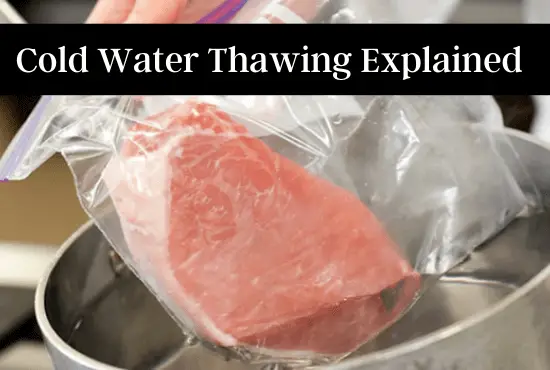So many ways to thaw the food, yet everybody seems to always stick to the cold water technique for quickly thawing the food. This method will enable you to thaw the uncooked food within an hour or so. By now, you must be getting really curious as to what is cold water thawing and how to get the best results using this technique?
Coldwater thawing is one of the most preferred ways of thawing food. The cold water thawing technique usually takes between 45-60 minutes (1 hour) to thaw a pound of meat. Food thawed this way shouldn’t be kept out of the freezer/fridge for more than 2 hours. To ensure food safety, you should follow the advised time frame and temperature.
Coldwater thawing might seem a bit hard, but the food that has been thawed this way is worth the effort. To learn more, check out this detailed guide.
Table of Contents
What is Cold Water Thawing? And How to do it?
Coldwater thawing involves the use of cold water to defrost the food. The process is quite simple, and you need to follow a few instructions only.
- Start by taking the bag of food out of the freezer and squeeze as much air as you can out of the bag.
- Place the bag containing food inside a bowl and fill it with cold water (temperature should be less than 40 F).
Note: Every single pound of frozen meat will take at least 25 minutes to thaw. Don’t forget to change the water once the 30-minute time limit passes.
Is Cold Water Thawing Safe?
When you are in a rush, your best bet to thaw the frozen food safely is by thawing it in cold water. There are other alternative methods of thawing meat faster, but those methods might cause a loss in overall quality.
If you are still wondering whether or not cold water thawing is safe. Then you should know that it is entirely safe to thaw food in cold water. However, you need to pay close attention to details like the thawing time and water temperature for the meat to stay in its best state after thawing.
Once you thaw the food in cold water, it’s not advised to pop it back into the freezer. It is because when you thaw the food, it gets exposed to the air for a long time; the exposure to air might make the food unsafe for refreezing.
However, it is safe to refreeze the food after cooking it. Properly cooking the thawed food will kill the bacteria that may have started growing inside the food while it was thawing. So cooking lowers the risk of food contamination and significantly extends the shelf-life.
Another thing to remember while thawing the food by this method is the use of a leak-proof, water-proof bag. It will ensure that no water enters the bag and the food remains dry. If the food is in contact with water, it will absorb the water and become soggy.
It is also essential to keep changing the thawing water every 25-30 minutes.
Thawing food in warm/hot water isn’t recommended, so make sure you change the water before it has reached room temperature or is no longer cold to the touch.
Cold Water Thawing Method (An Easy Way To Defrost Food Especially Meat)
Most food officers and experts recommend thawing the meat in a refrigerator for maximum safety and proper thawing. Slowly thawing the meat in a refrigerator also allows it to remain in a better state after cooking. It also ensures there’s no colossal degradation in the quality or loss of flavor.
Thawing the food in the refrigerator also lets you refreeze the thawed food without cooking. Other thawing options don’t offer this benefit.
However, if you are in a hurry and need to cook the food immediately, you would want to go for a faster way to thaw it. In that case, thawing the meat in a microwave will be ideal for you.
Though defrosting the meat in a microwave is the fastest way to defrost it, there are a few disadvantages to thawing it in a microwave. The first one is, sometimes the upper layer of meat might thaw earlier and start cooking while the inner layers are still frozen. If you cook the food without defrosting it properly, you will be disappointed by the taste and texture of the meat.
Moreover, microwave-thawed food isn’t safe for refreezing. So, if you have the slightest doubt that you might need to refreeze the food, you should avoid thawing it this way.
If you need to thaw the meat immediately but want to avoid using a microwave, you can thaw it in cold water. Coldwater thawing is a classic way to thaw the food, often used by different chefs and cooks.
Thawing the meat in cold water will take anywhere between 25-30 minutes for every pound. This method is ideal for thawing meat in smaller quantities. However, it is not advised to thaw the more significant amount of meat in cold water.
What’s the ideal temperature and time frame for cold water thawing?
When thawing any food in cold water, it is essential to take care of the temperature and time you give each thaw. Thawing the food at the wrong time and temperature might cause it to go bad while thawing. On the other hand, food that hasn’t been thawed for a sufficient time might carry the risk of bacterial contamination.
Temperature
The ideal water temperature for cold water thawing should be 40 F or less. The colder the water, the quicker it will melt the ice away.
Time Frame
Most meats take a maximum of 30 minutes to thaw per pound. If you are dealing with meat in a larger quantity, it will take longer to thaw completely; you’ll have to give 30 minutes to each pound. Doing so will ensure the meat thaws properly.
Conclusion
Coldwater thawing is the best way to thaw food when you want to avoid using the microwave for thawing. This method requires you to put in a little more effort. However, the results are worth it as the food resists any loss of quality, flavor, and texture.
Coldwater thawing involves immersing the food in an airtight bag for 30 minutes. In the case of meat, every pound needs at least 30 minutes to thaw. Once the meat has thawed, you should cook it immediately, or it may spoil.



